Gaza Freedom March Marches in Cairo Against Egyptian Blockade
Sharat G. Lin | 05.01.2010 11:04 | Palestine | Repression | World

Gaza Freedom March marching in Cairo on 31 December 2009
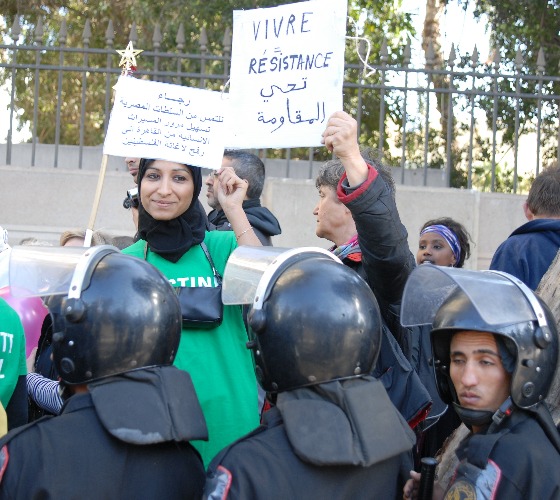
“To live is resistance” French delegates camped at French Embassy for 4 days
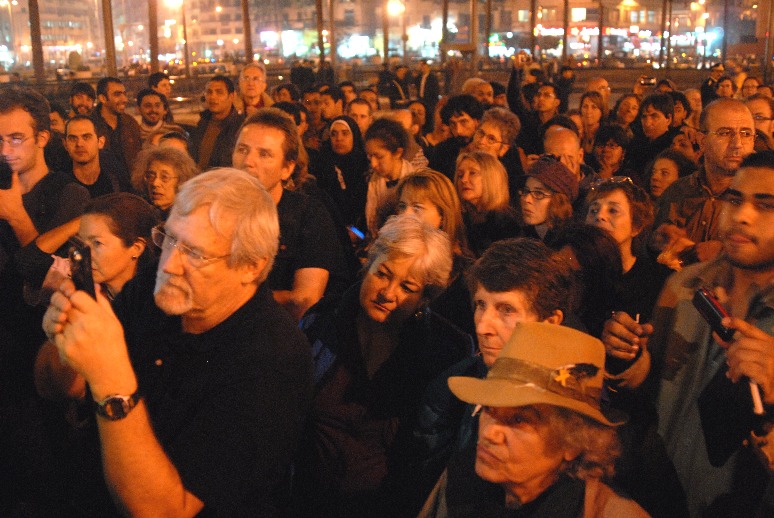
Meeting on 27 December 2009 in defiance of Egyptian government ban
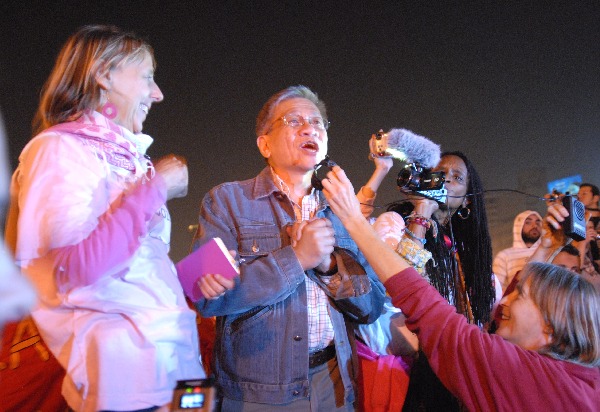
Medea Benjamin and Walden Bello speaking in front of El-Mogamma
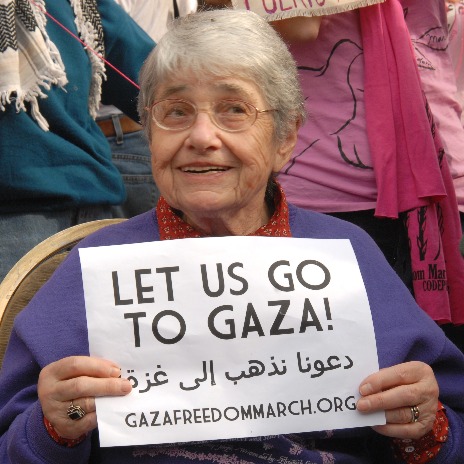
Holocaust survivor, Hedy Epstein, 85, on hunger strike on 28 December 2009
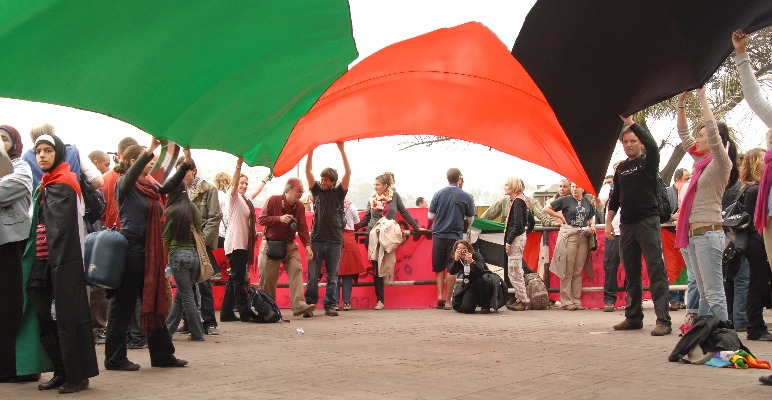
GFM delegates unfurl giant Palestine flag at WTC Cairo on 28 December 2009
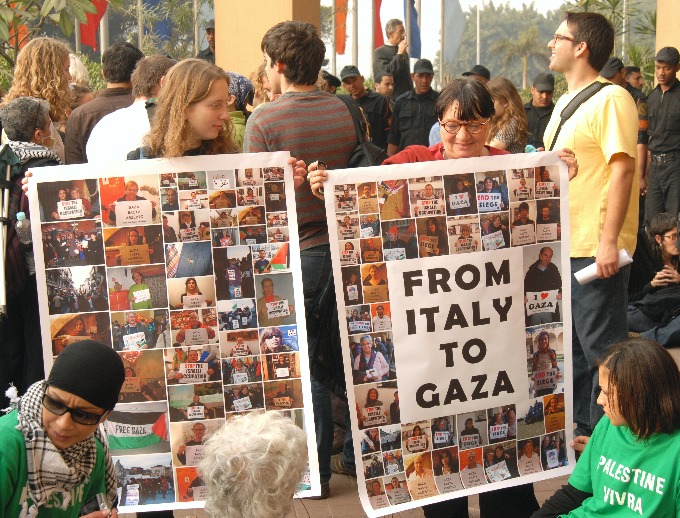
“From Italy to Gaza,” led by European parliamentarian Luisa Morgantini
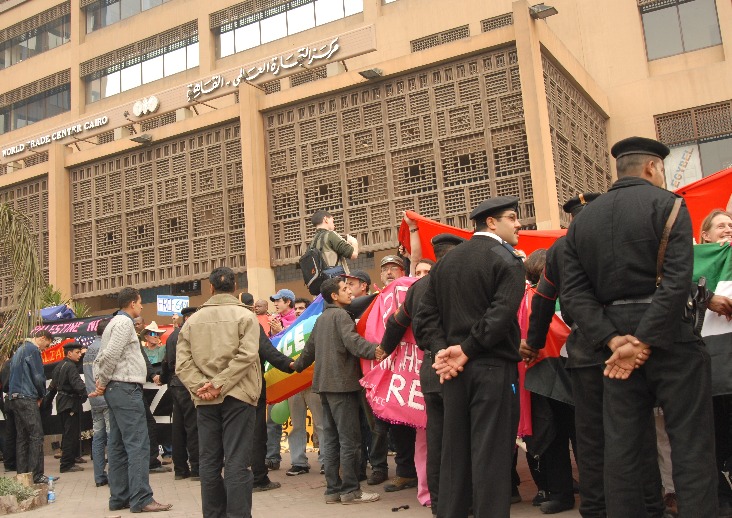
GFM rally at WTC Cairo on 28 December 2009 to press for UN backing
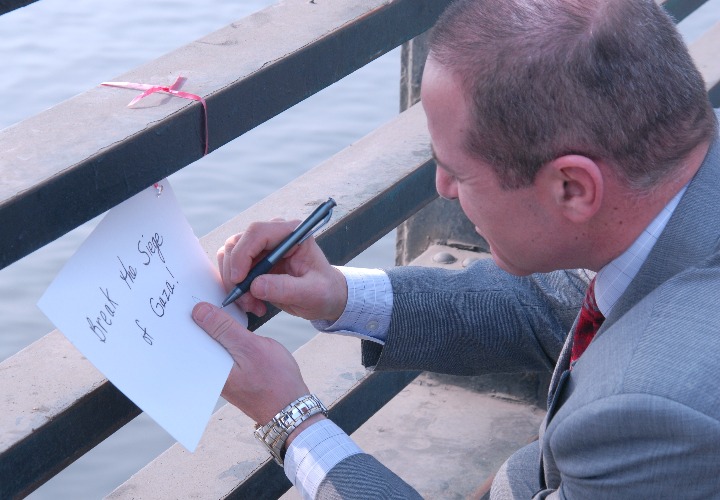
Letter to Gaza tied to Qasr el-Nil Bridge on 27 December 2009
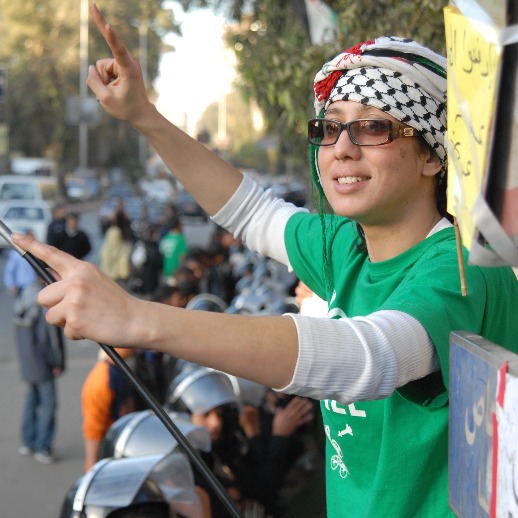
French delegate pierces visual blockade by Central Security Forces
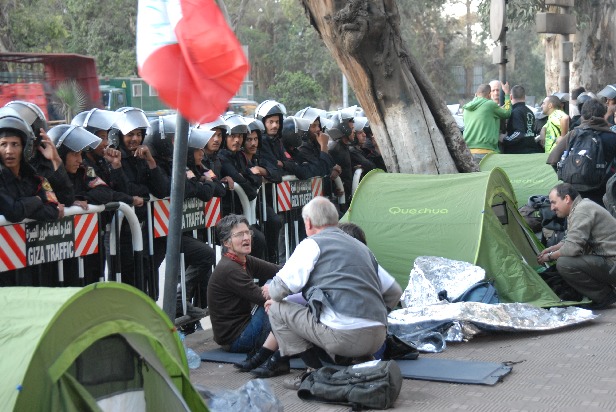
Four-day encampment in front of French Embassy behind security cordon
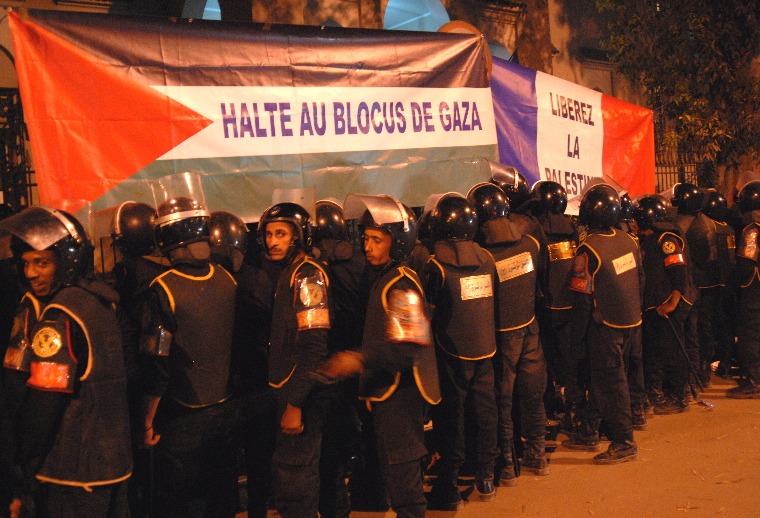
Egyptian Central Security Forces form visual blockade of French encampment
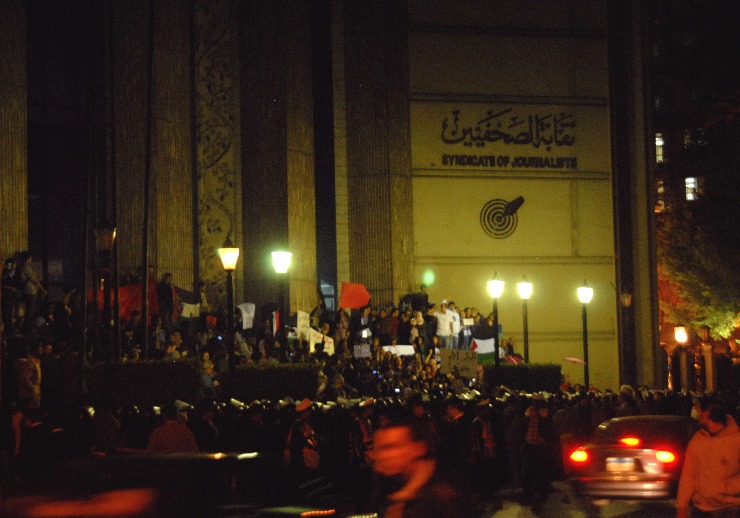
Gaza Freedom March at Syndicate of Journalists on 29 December 2009
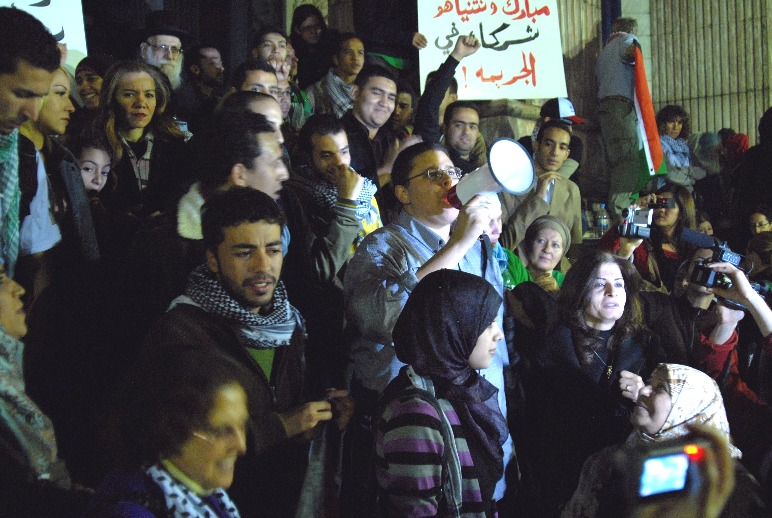
Egyptians call for “revolution” at Syndicate of Journalists building
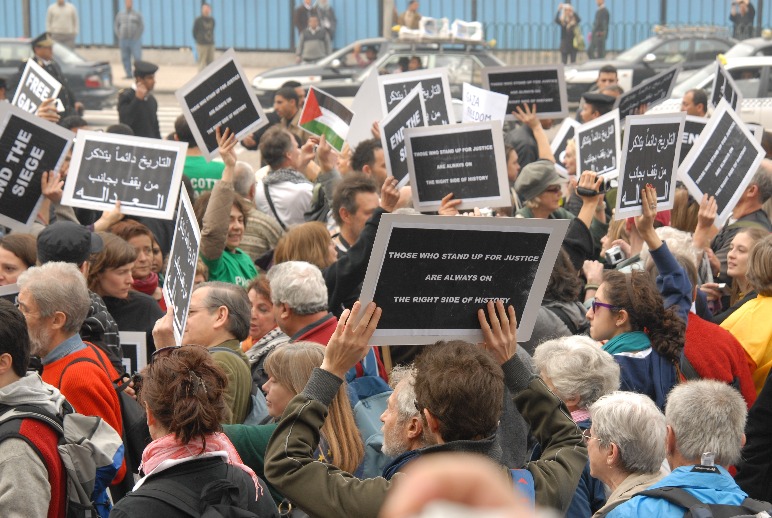
“Swarm of bees” holding the streets of downtown Cairo for a half hour
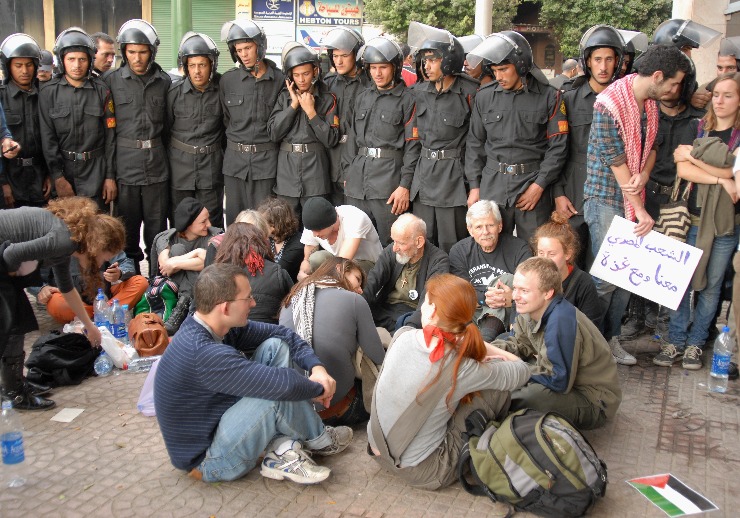
Gaza Freedom marchers occupying “Free Gaza Square” on 31 December 2009
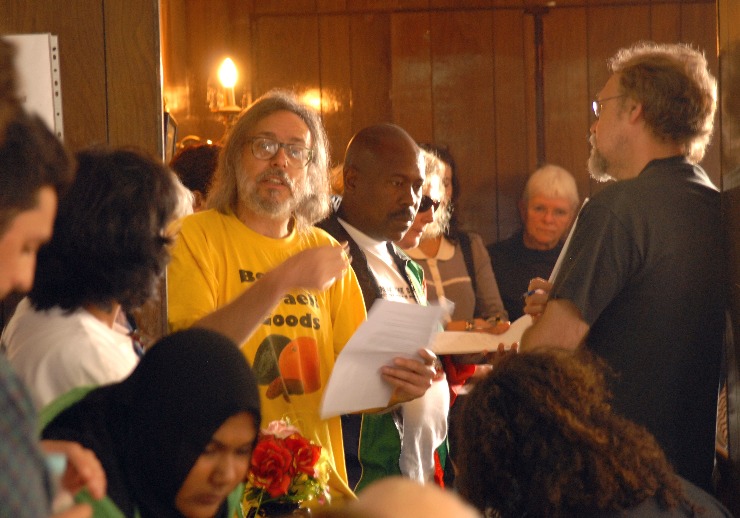
The Cairo Declaration was ratified in the Lotus Hotel on 1 January 2010
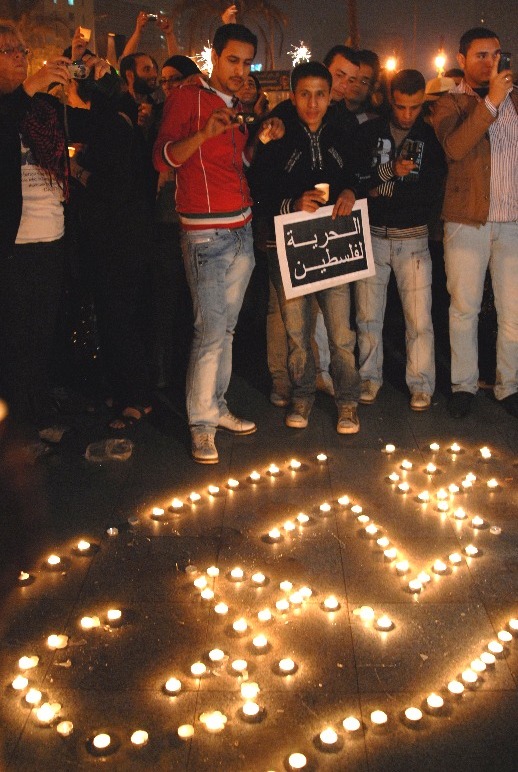
New Year candlelight vigil for Gaza
The Gaza Freedom March sought to highlight the plight of the 1.5 million residents of Gaza on the first anniversary of the Israeli invasion of the densely-populated Palestinian territory by entering Gaza with humanitarian aid for water purification, school materials, medicines, and other much needed supplies. After Israel tightened its blockade on Gaza after the election of a Hamas majority in the elections of January 2006, Egypt has refused to give open permission for foreign citizens to enter Gaza through Rafah until the last minute. Organizers of the Gaza Freedom March had been hopeful of obtaining permission, but were disappointed when Egypt closed the Rafah border in December 2009 under intense pressure from Israel.
The French ambassador to Egypt, Jean Félix-Paganon, told members of the French delegation of the Gaza Freedom March that the Egyptian government was preparing to grant permission for the March to proceed to Gaza until the deal was rejected by Israel. With 1,360 delegates from 43 countries converging on Cairo, Egypt revoked the permit to hold a large meeting in Cairo and the permits for buses to take them to the Rafah border via El-Arish.
Protesting the Egyptian Blockade
In response, the Gaza Freedom March launched protests in the streets of Cairo on 27 December 2009. The day began with a silent action, tying letter cards expressing solidarity to the people of Gaza to the railings of the Qasr el-Nil Bridge. Many Egyptian passersby stopped to add their own messages of friendship to the people of Gaza and Palestine. When police finally broke up the vigil, they ripped the cards off, leaving only the strings by which they were attached.
In the late afternoon, a plan to sail in dozens of feluccas (traditional Nile sailboats) was aborted by police, who closed off an entire section of the Cornish el-Nil where the feluccas are docked. The purpose of going onto the Nile River was to float 1,400 candles in biodegradable cups in memory of the Palestinians who died in the Israel assault one year ago. Gaza Freedom March delegates held their candlelight vigil anyway along the busy Cornish el-Nil street.
The more than 300-strong French delegation had gathered in front of the French Embassy in Giza, expecting to board buses for El-Arish. When the buses failed to arrive because their permits had been pulled, the delegates in a courageous act of defiance sat down in the busy four northbound lanes of Murad Street and set up tents. Hundreds of riot police from the Central Security Force were mobilized to enclose the protesters and move them onto the footpath in front of the French Embassy. Not knowing what the police would ultimately do, there was a great deal of fear at the beginning of the action. At one point the security force cordon increased to three layers. However, the French ambassador was apparently supportive, discouraging Egyptian authorities from using force and pressing for permits to travel to Gaza. Towards the end, the security cordon was relaxed, allowing anyone to freely enter and exit the encampment. The encampment lasted continuously for four days.
French delegate, Amar Aknouche, said he decided to join the Gaza Freedom March because of the injustice in Palestine. He noted, “Israel is the only ‘democracy’ which goes and kills children and erects an apartheid wall. I came here to express my solidarity with Gaza.”
Other large delegations – U.S., Canadian, British, Italian, etc. -- approached their own embassies to appeal for support in pressuring the Egyptian government to open the Gaza border. The U.S. and Canadian embassies were particularly unhelpful because their governments had taken an official position of not dealing with Gaza because they classify Hamas as a “terrorist” organization. An additional special delegation went to the offices of the Arab League to seek its intervention.
Non-violent Civil Disobedience
When the Egyptian government revoked the permit for Gaza Freedom March delegates to meet in a church compound, organizers defiantly moved the meeting into the open, directly under the nose of the state in the plaza in front of El-Mogamma, the monolithic state office building that houses the public entry point into much of the central government bureaucracy. Police quickly moved in to try to stop the assembly, demanding, “Stop it! Stop it! This is not allowed!” Delegates then burst into singing, and the police reluctantly melted away into the shadows of the crowd. Such can be the power of song and non-violent civil disobedience!
Meanwhile, other Gaza Freedom March participants defied the lack of permits to travel to El-Arish. Thirty arrived successfully and checked into a hotel, after which they were placed under house arrest. After diplomatic negotiations, they were allowed out of the hotel, but blocked from going to the Rafah border. Over several days another fifty delegates boarded commercial buses at different times in Cairo and successfully passed through the multiple checkpoints outside of Cairo and along the highway from Bur Sa’id to El-Arish. However, they were all halted at the bus stand in El-Arish or at the final checkpoint before entering El-Arish. Police forced all foreign travellers, including those holding Palestinian passports, back towards Cairo under police escort at least up to the Suez Canal. Eight Europeans refused to go back, choosing instead to camp out at a checkpoint. A subsequent directive of the Ministry of Interior blocked all non-Egyptians from travelling east of the Suez Canal.
On 28 December, while negotiations continued with the Egyptian Ministry of Foreign Affairs for permits to enter Gaza, a new avenue was opened through the United Nations office in Cairo. A negotiating team led by Philippine parliament member Walden Bello met with U.N. officials, but to no avail. Bello confided, “I know it's a bit difficult right now with the situation here, but I don't think they will be able to keep us away from there [Gaza] forever.”
The negotiating team was supported by nearly a thousand delegates rallying in front of the World Trade Center Cairo where the U.N. office is located. The scene was abuzz for hours with chants of “We want to go to Gaza,” “Free Gaza,” “We shall overcome,” and many more. There was music led by guitarists and an accordion player. Meanwhile, organizing meetings in the various national delegations were constantly going on in the background.
Eighty-five-year-old Holocaust survivor, Hedy Epstein, used the occasion to announce her hunger strike to demand passage to Gaza. She explained, “I have come to a point in my life in regard to the Israeli-Palestinian issue, especially the Gaza issue, where I think I need to do something else because what I have done so far has not really caught the attention of my own government or the governments of the world who are silent on this issue. And so I've decided to go on a hunger strike.” She was quickly joined by others.
As at the French Embassy, the rally was visually contained by a solid wall of black-uniformed members of the Egyptian Central Security Force. But the wall could not hide the banners, Palestinian flags, and chants that flew high above the security cordon. The young recruits frequently expressed sympathy and smiles with the delegates. One symbolically crossed his wrists, signalling that his hands were tied. The Central Security Force recruits carried no arms, and have not done so ever since a 1987 mutiny. However, police (some of whom are armed) did filter the crowd and remove three Egyptian nationals. They also removed one Palestinian American woman, punched her in the face, and then released her. Twelve international delegates remained camped at the World Trade Center overnight.
Many Egyptian passersby and people in buses and cars also signalled their sympathy by waving to the delegates, for the Gaza Freedom March was exercising a limited freedom of assembly and speech accorded to internationals that would not be permitted among Egyptians.
On 29 December, the Syndicate of Journalists invited the Gaza Freedom March to join their members at their trade union headquarters for a rally for Gaza that lasted into the evening. Some Palestinian and Egyptian speakers moved beyond lifting the blockade on Gaza to chanting “down with Hosni Mubarak” and calling for “revolution.” The combined voices of Egyptians and internationals sent a powerful message of unity and solidarity on Palestine and opposition to the Egyptian government’s role in upholding the blockade on Gaza.
Divisive Breakthrough
Code Pink organizer, Jodie Evans, used her personal contact with Suzanne Mubarak, wife of President Hosni Mubarak, and chairwoman of the Egyptian Red Crescent (ERC), to appeal for permission for the Gaza Freedom March to carry its humanitarian aid into Gaza. The response from Mrs. Mubarak’s office was positive with instructions to “help in any way possible.” After reviewing the details of the request, by the next day Mrs. Mubarak secured permission for 100 delegates and two buses to cross into Gaza on 30 December morning. Code Pink organizers were given only two hours to come up with a list of names.
The initial acceptance of the offer proved to be tactically divisive for both the Gaza Freedom March and for the Egyptian government. After raging internal arguments and Palestinian calls for “all or none,” the Gaza Freedom March belatedly, but wisely, decided to decline the offer and allow only Palestinians with family in Gaza, key media personnel such as a Telesur team, and a handful of individuals to deliver humanitarian aid to board the buses. Meanwhile, Mrs. Mubarak’s intervention reportedly enraged Egyptian Foreign Minister Ahmed Abu al-Gheit for having undermined his ministry’s monopoly over political decision-making on the Gaza border crossing. He, in turn, tried to drive a wedge through the Gaza Freedom March by praising those selected (falsely as if by the government) to go to Gaza as “good and sincere,” while denouncing those remaining in Cairo as “hooligans” “acting against Egyptian interests.” Fortunately, that divide-and-rule tactic only served to unify delegates.
Free Gaza Square
On the day of the actual Gaza Freedom March from both sides of the wall (Gaza and Israel) to the Erez Crossing, 31 December 2009, delegates in Cairo planned to symbolically “march to Gaza” by walking peacefully in the streets of downtown Cairo. But because of the official ban on public political demonstrations, organizers adopted the tactic of initiating the march with “flash mob” and “swarm of bees” techniques. It worked for only about twenty minutes before the “swarm” became trapped between the traffic and hundreds of police.
In the ensuing melee, a solid wall of Central Security Forcers first began pushing demonstrators away from trapped buses, with officers attempting to ram the human wall from behind. Once the buses were cleared out of the way, police (not Central Security Forces) began grabbing delegates and throwing them onto the footpath. Some officers used fists to hit delegates, including several women. Two reported that their headscarves were ripped off. Seven delegates were reportedly injured. One American man had blood on his face that required treatment at the medical station set up by march organizers. He had been clubbed with a two-way radio by a plainclothes police officer.
Once confined to a 500-square-metre area of footpath, Gaza Freedom March delegates erected banners and Palestinian flags, and proclaimed the site “Free Gaza Square.” Within its confines they spoke about the political accomplishments of the week, and the unfinished tasks ahead. Challenged by the lack of democratic rights in Egypt, delegates were more determined than ever to break the siege of Gaza and challenge their governments’ acquiescence to the blockade.
Ali Abunimah, a founder of Electronic Intifada, observed, “Gaza is harder to visit than a prison. They are turning back all the buses. It is too bad we didn’t get into Gaza. But the most important thing is that Al-Jazeera has carried it [Gaza Freedom March protests in Cairo] throughout the Arab world.”
Another participant observed, “One positive development is that we raised more media attention about the plight of Gaza by demonstrating in the streets of Cairo that we would have by marching in Gaza” due to the comparative lack of media access to Gaza.
Late in the evening, hundreds of Gaza Freedom March delegates gathered once again in the open plaza in front of El-Mogamma to hold a candlelight vigil to celebrate the new year. They held candles and arranged more candles on the pavement to create the luminous word “Gaza” within a circle. People spontaneous began passing out sweets. The novelty of this action was immensely popular with Egyptian passersby who joined in the hundreds, swelling the crowd. Then plainclothes police moved in to filter out and sweep away all Egyptian nationals. Even simple collective celebration of the new year is a “luxury” not available to Egyptians. A double-row contingent of the Central Security Force also moved in, until senior commanders were told to back off, removing the contingent to a distant corner of the plaza. The state itself held no official new year festivity, as if fearing its own future.
The Cairo Declaration
In the new year, the Gaza Freedom March concluded with three important events. First, it convened an ad hoc convention to ratify the “Cairo Declaration” jammed into a small hotel restaurant. In a move spearheaded by the South African delegation, an international working committee drafted a document putting forth a globally-unified plan of action for boycott, divestment, and sanctions against Israeli apartheid and “to compel Israel to comply with international law.” With the concurrence of civil society representatives in Gaza and the West Bank, the document reaffirms commitments to “(1) Palestinian self-determination, (2) ending the occupation, (3) equal rights for all within historic Palestine, and (4) the full right of return for Palestinian refugees.” The historic document includes 128 initial signatories from 16 countries.
Second, the Gaza Freedom March hunger strikers held a press conference at the Syndicate of Journalists to conclude the official hunger strike, although a few vowed to continue their hunger strikes until they returned to their home cities. Over the course of the hunger strike, the number of participants had swollen to 27. Hedy Epstein said that she felt “strengthened” by her actions seeking justice for the people of Gaza.
There was the usual Central Security Force cordon. But it was plainclothes police that disconnected and took down the al-Jazeera video camera and escorted the cameraman away from the scene. In previous incidents during the Gaza Freedom March, three Egyptian journalists had been arrested for photographing demonstrations, and one was arrested in the midst of interviewing a Gaza Freedom March delegate. One Egyptian photojournalist asked me to send a photograph, saying that, “I would be arrested for taking photographs of the demonstrations. Egypt is no democracy.”
Third, a flash mob demonstration was organized in the afternoon in front of the high-rise building housing the Israeli Embassy. Demonstrators rapidly appeared from the south side of the traffic circle between the University Bridge and the Giza Zoo. For at least ten minutes, demonstrators swarmed throughout the crossroads and the end of the bridge before Central Security Force personnel in riot gear arrived to move them onto a narrow strip on the south side of the bridge opposite the Israeli Embassy. While there was little police intimidation inside the security cordon, aggressive harassment by plainclothes police outside the cordon was particularly severe. One French cameraman was physically threatened on the University Bridge even as he was walking away from the demonstration and showing his French passport.
Shortcomings and Accomplishments
Mass media coverage of the Gaza Freedom March in Cairo had reached around the world, even though many major western media networks refused give more than cursory attention. In Egypt, the events received front-page coverage in opposition newspapers like Al-Wafd, Al-Sharouq, al-Dastur, and the independent Al-Masri al-Youm and Daily News Egypt. But newspapers like the semi-official Al-Ahram, and government-owned Al-Akhbar and Al-Gumhuriya ignored the events as if they did not exist. Yet even the pro-government Egyptian Gazette could not avoid publishing a front-page photo of the demonstration at the Israeli Embassy. While avoiding day-to-day coverage, Al-Arabi and Al-Karama end up splashing headline photos of Gaza Freedom March activities in their weekend editions.
Except for the Syndicate of Journalists, the relative absence of Egyptian participation and solidarity with the Gaza Freedom March could have been interpreted by delegates as the result of either severe political repression or political indifference. But anti-government Egyptian activists pointed out that Gaza Freedom March organizers failed to reach out to them and establish coordination. In fact, Egyptian labour unions, students, and organizations of civil society have a long history of struggle in the streets of Cairo and other towns for democratic rights in the face of the overwhelming force of the state apparatus. Nevertheless, six full days of political demonstrations in Cairo by a large group of visiting internationals is without historical precedent.
The struggles in Cairo and the new construction of a steel wall deep into the earth at the Rafah border also highlight the fact that the Egyptian government has been bought by U.S. aid following the Camp David Accord of 1978, in this instance to help enforce the Israeli blockade.
Delegates of the Gaza Freedom March were defeated in their desire to travel to Gaza, but, as a result of the struggles in the streets and embassies of Cairo, they were more determined than ever that the blockade of Gaza by both Israel and Egypt must be lifted. Bitur Nabi Tammam of Bahrain saw the bright side, “Even if they don't allow us to cross, I think it has accomplished the purpose that from all over the world you see people left their families, left their homes, to come here to say 'freedom for Gaza,' 'freedom for Palestine,' 'open the gates!'”
Sharat G. Lin is president of the San José Peace and Justice Center and writes on global political economy, the Middle East, South Asia, and labour migration. He wrote this report from Cairo.
Sharat G. Lin